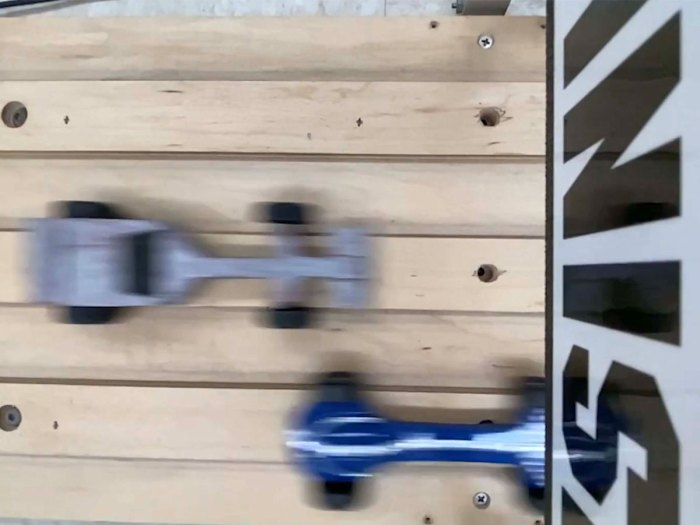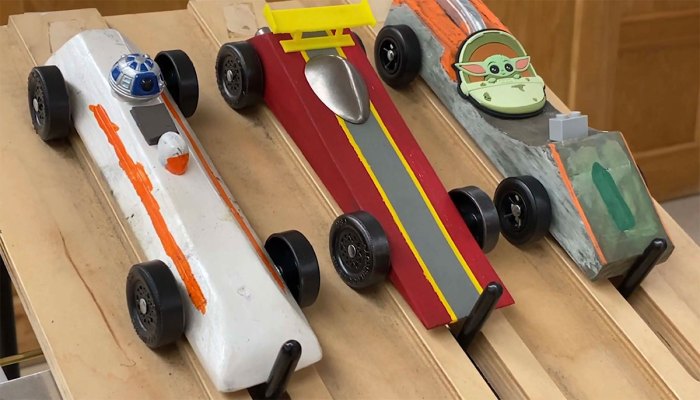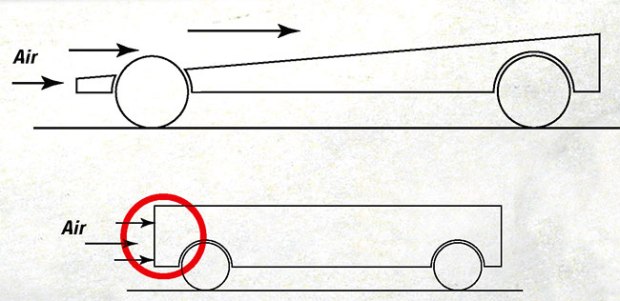How to Make a Fast Pinewood Derby Car

Packs nationwide are gearing up for their annual Pinewood Derby race, and the one thing everyone wants to know: How do I make a fast Pinewood Derby car?
There are a variety of ways to make your Pinewood Derby car go faster. Explore the following tips to optimize your car’s performance and gain a competitive edge in an upcoming race.
BASIC BUILDING GUIDELINES TO GET YOU STARTED
The possibilities are endless when it comes to creating a fast Pinewood Derby car. Before you begin, consider the following general guidelines:
Avoid Pointed Noses: A pointed nose will make it difficult for your car to rest on the pin at the starting gate. It may also cause your Pinewood Derby car to get bumped around when the pin drops, and it can create problems for electronic timing systems at the finish line.
Weight Distribution: Leave ample wood in the rear of the Pinewood Derby car so you can place additional weight there. Concentrate the majority of the weight in the rear for optimal performance.
Maximum Weight: Aim for the maximum allowable weight allowed by your pack’s rules, typically limited to 5 ounces in most races. If your car falls short of this weight, strategically add coins or other weights to meet the requirement.
Clarity in Orientation: Clearly distinguish the front and back of your Pinewood Derby car. In many races, the race officials — not you — will actually place each car on the track. Sometimes the officials put cars on the track backward because they can’t tell which end is which.
Aerodynamic Design: Select a design that facilitates smooth airflow over and around the car body. Pinewood Derby cars with aerodynamic profiles go faster.
Need design ideas? See photo galleries of hundreds of Pinewood Derby cars.

10 STEPS FOR DESIGNING AND BUILDING A FAST PINEWOOD DERBY CAR
You don’t have to strive for the fastest Pinewood Derby car to have fun competing in your Pinewood Derby. But if you and a helpful adult are willing to put in the extra time and effort, these speed tips are for you.
1. Bake the Block: Start your Pinewood Derby car project by baking the wood block at 250 degrees for two hours. This removes moisture and lightens the block, allowing you to place more weight at the rear of the car where you actually want it.

2. Crafting the Design: Outline your Pinewood Derby car on paper, cut it out, and affix it to the wood block.
Remember, a rectangular car is not an aerodynamic design. The most basic aerodynamic design is a simple wedge. If you don’t have time to design a complex car, a wedge will work just fine.
Download a Pinewood Derby car template PDF to help you create your design.
3. Rough Cut the Design: Use a coping saw or enlist the help of a responsible adult with a power tool to cut out the rough shape of your Pinewood Derby car.
4. Shape Your Car: Smooth edges and shape your car using sandpaper. An adult can assist with a rotary tool or other shaping tools.
5. Sand and Paint Creatively: Reduce friction by smoothing the car’s surface and paint an awesome design to make it look great.
How to paint your Pinewood Derby car to give it a shiny finish.
6. Axles and Wheels Alignment: Make sure they are aligned perfectly straight. You can test the alignment of your axles by pushing your car across a smooth floor or table. It should roll smoothly in a straight line.
- Consider a Three-Wheeler: Raise one wheel about 1/16 inch higher so it never actually touches the track. Less friction = more speed. Rules vary from pack to pack, so make sure to check your pack’s Pinewood Derby rules to make sure three wheelers are allowed in your race.
- Extend the Wheelbase: Maximize the distance between front and rear wheels. Again, make sure this is allowed in your race.
Inspect axles closely to make sure they are smooth without ridges or burrs. You can use sandpaper to remove any imperfections.
Learn about polishing Pinewood Derby axles and wheels to reduce friction.
7. Secure Axles with Glue: Glue the axles firmly in their holes to ensure that they stay perfectly placed, but make sure you don’t get glue on your wheels.
8. Strategic Weight Addition: Remember to make your Pinewood Derby car as heavy as the rules allow. In general, it’s best to place weight to the rear of your car because a heavier rear increases speed.
Learn scientific Pinewood Derby speed tips from a former NASA engineer.
9. Use Graphite: Add graphite or another dry lubricant to reduce friction. The less friction between the body and wheel, the better.
10. Have fun! And finally, remember the most important rule of a Pinewood Derby is that it’s supposed to be fun. While you should always strive to do your best, don’t get caught up in winning or having the fastest car. Just enjoy the ride.
Adapted from the book “Pinewood Derby Speed Secrets,” DK Publishing, $12.95 softcover.
last year i won a award
i made a car last year and it popped a whelie because i had too much weight in the back but it backfired and caused MORE friction because the back of the car touched the track so don’t place too much weight in the back of the car
One of the secrets is against a rule; Raise one tire 1/16 off the track.
i would use these tips but i am going to boy scouts before that.
Puting the wait in the back really helps. thanks BoysLife!
pinecar is a good company for decals car building hints and pre made cars (i don’t like the pre made cars but you might) they also have books and dvds full of tips and hints to make a great car you can find them in the hobbie section of most hobbie lobbys ps they are bsa aproved unless it say other wise
As a Den Leader we try to follow the BSA rules, and as such I have an issue with the numbers, 5 and 6 on the secrets list, they say to make it run on 3 wheels, and to extend the wheel base, both of which are against the BSA Rules. I would hope that all you scouts out there will not think about cheating just because these tips are on this site. Have a great race.
Pack 16, Athol, MA.
Be sure that any of the hints to make your car faster don’t make your car illegal. For instance, our council doesn’t allow a pointed front (must be flat for 3/4 of middle), nor can we extend the wheelbase, it must be factory cut. Not all speed tips are equal or a good idea. Check the rules before you run with it! Good luck racing.
Every cub’s dream is to have a cool looking car and have it fast. Are they both possible at the same time though? With these tips it can be.Tip 1: model your car after a race car. The real thing goes fast, so why shouldn’t your derby? Tip 2: like the packet above says you need lots of weight in the back. Try drilling a hole in the back and filling it with lead. (Make sure you get it weighed first.) Tip 3: Think of cool models that look good aerodynamic. One year I had a rocket that had a point at the front ,after that it slanted up to go fast. It almost won before it broke during the race☻. Tip 4: Try using metallic spray paint for a nice shine.
MAKE SURE TO HAVE FUN!!!!!!!!!!!!!!!!!!!!!!!
The critical point in making the car fast is to be absolutely sure, or at least as sure as you can be, that the wheels are running true and smoothly. Polish the axles where the wheel rides on them to remove all burrs on the axles, polish the insides of the wheel hubs with pipecleaners and smooth the tread surface of the wheels to remove all mold marks. Be absolutely sure the axles are perfectly aligned with a 90 degree angle from the track surface and precisely perpendicular to the axis of the car body. Use plenty of dry, powdered graphite to lubricate the wheels and get the weight of the car just as close to the maximum allowed with weight inserted in holes drilled in the rear of the car and fastened low on the sides of the car between the front and rear wheels.